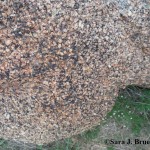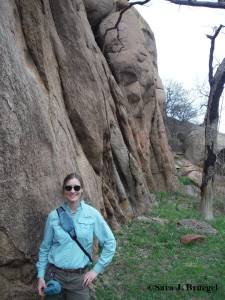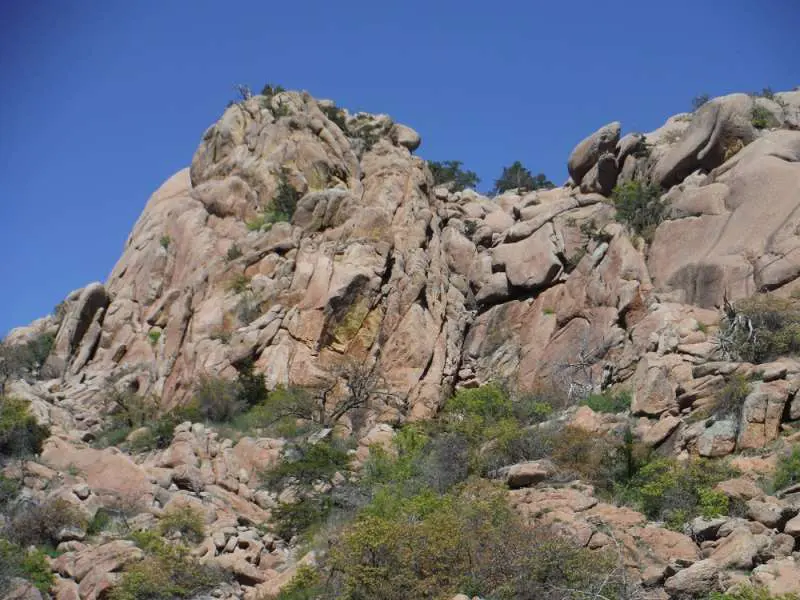
Inching my way across the steeply tilted rock, I grabbed the top edge to keep myself steady. The rock felt very rough and sharp. By the end of the day, I had sore, red palms and scratched, bloody knees. These granite rocks were hard and rough, but incredible and fascinating. A few weeks ago, I went camping at Wichita Mountain Wildlife Refuge in Oklahoma (more about that trip here). When you think of mountains in America, states like Colorado, New Mexico, and Montana probably come to mind long before Oklahoma. The Wichita Mountains have a story behind them different from the enormous western Rocky Mountain chain.
The main type of rocks found in Wichita Mountains is granite. Granite is a very beautiful type of rock made by magma (lava is above ground and magma is underground) squeezing up into pre-existing rock. It then hardens and crystallizes, separating into three different minerals that you can see in the speckled patterns of granite (more about granite here). The granite of Wichita Mountains looks like it’s had a pretty rough life, battered and worn, as if to say, “you have no idea what I’ve been through”. Truly, the catastrophe these mountains have been through is unlike anything we see today. This rock probably went through the entire global flood, mentioned in the Bible.

While there are a couple of different interpretations you could have of exactly when this granite formed, we can tell that it has been around since at least the beginning of the flood. One thought is that this rock formation could be creation rock, made on day 3 of creation week, when God separated the waters and created dry land (Genesis 1:9-10). However, it seems more likely that this granite started forming at the very beginning of the flood, when the “fountains of the great deep” began to break up. This would have caused volcanoes, earthquakes, magma pushing up into layers, and more. The continents also would have started to break apart at this time. On the classic geologic column, this granite is classified as Pre-Cambrian to Cambrian. Other types of rock made by underground magma and above ground lava were formed in the area around the same time.

This granite was formed by magma squeezing into the Tillman rock group. It was covered by flood waters and mud layers. Still in the early phases of the flood (classified as “Carboniferous”), Wichita Mountains began to rise as sections of earth’s surface were squeezed, pulled apart, and pushed up. Progressing farther into the flood (Permian rock sections), these mountains were worn down quite a bit by the flood waters, and covered with more mud and gravel. Later, that mud and gravel was cleared away, revealing Wichita Mountains. Wichita Mountain is a beautiful monument of the world-wide flood and the awe-inspiring power of God. The next time you feel like Wichita Mountains – covered by the deep waters, battered, and worn – remember that you, too, can be a monument of the power of God to all who see you.
Copyright Sara J. Bruegel, April 2016
References:
Excerpt from the C.A. Merrit, School of Geology, University of Oklahoma and the Programs in Geosciences at the University of Texas at Dallas. U.S. Fish & Wildlife Service. Wichita Mountains Wildlife Refuge. Oklahoma. Last accessed 4-21-16. http://www.fws.gov/refuge/Wichita_Mountains/habitat/geology.html






Well written & well documented, Sara.
Keep up the good work for His Glory!!!
In His Love,
Dr. Jack L. Burton
-Hebrews 11:1-3
Thank you, Dr. Burton! God bless ~ SJB